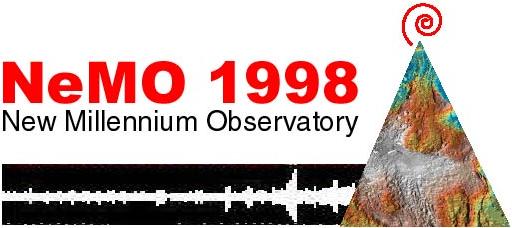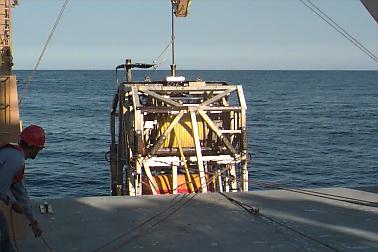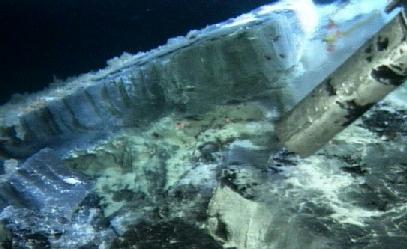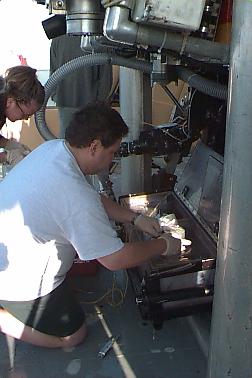WHAT'S NEW:
Eruption Confirmed!
New lava (rumbleometer stuck in flow) SE rift zone
(posted 9/1/98)
BACKGROUND:
Technology (ROV, ships, etc.)
Other 1998 Axial cruise reports
EXPEDITION:
Science Objectives
Calendar
Today's Science News
Participant Perspective
Teacher Logbook
EDUCATION:
Curriculum
Teacher Observations
Questions/Answers from sea
MULTIMEDIA:
(video clips, animations, sounds)

Logbook
August 31, 1998
August 31, 1998
Contents:
Science Report
August 31, 1998
Scientists were very busy turning the ROV over for a dive today and have given a summary of the day's events on tomorrow's science summary.
Teacher's log is still to come (stay tuned).

ROPOS coming back onto the Ron Brown deck (photo:S.Merle NOAA Vents)

Rocks heavily coated with bacteria photographed on ROPOS Dive #3 (photo: ROPOS NeMO 1998)

Scientist Craig Moyer recovering bacteria samples from the "BioBox" on ROPOS after a dive (photo: S.Merle NOAA Vents)
Listing of all Science News postings
Life at Sea: Participant Perspective
Jon Kaye
Graduate Student, University of Washington

Don't be tricked by the animal biologists or rock jocks aboard the R/V Brown. Those animal folks count the number of little hairs on the little legs of little worms. Not only is that gross, but would you enjoy counting how many tiny hairs are in your nose? And the geologists end up measuring the same chemicals that make up rocks, time and time again (yawn!).
The MICRObiology is the coolest aspect of exploring the deep-sea hydrothermal-vent system. Microbes are so small that you could stack 1,000,000 of them end to end in a space of only 3 feet! But microbes are so numerous that they change the entire deep-sea environment; from how it looks to what chemicals it contains. Some of them can also do the coolest tricks; like live at temperatures of up to 115 C (that's HOTTER than boiling water, but under pressure water won't boil!). Some others will eat toxic compounds for breakfast. Indeed, hydrothermal vents are the most extreme environment on Earth, and the microbes inhabit almost every niche available.
I'm a third-year graduate student at the University of Washington in Seattle. Since I arrived there, I've been studying deep-sea hydrothermal vent microbes that can jump through every physiological hoop I threw at them. This includes culturing "bugs" (as we like to call them) at cold and hot temperatures (near the freezing and boiling points of water), exposing them to toxic chemicals like arsenic and mercury, and also testing whether some of these marine microorganisms are able to cope with wide variations in how much salt is around, from freshwater conditions to salty fluids that are 10 times saltier than the ocean. And, guess what? The different microbes that I work with are able to conquer these different stresses. It amazes me constantly. I know that no animal could ever cope with the conditions I throw routinely at hydrothermal-vent "bugs." If you want to learn some more about these extremophiles (as we call them), you can also check another website: Go to ABC News Science section, and look for the link to more details on what I'm up to during this deep-sea expedition.
Jon Kaye
Listing of all Perspectives postings
Teacher At Sea Logbook
Question/Answer of the Day
Send Your Question to NeMO
Back to Calendar